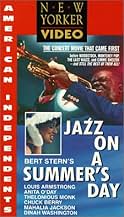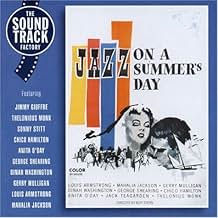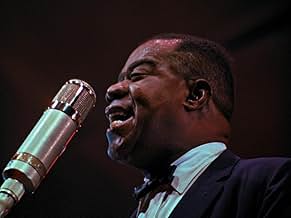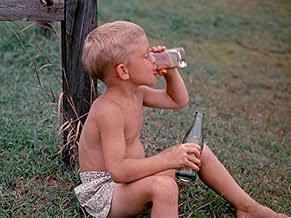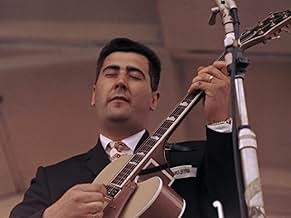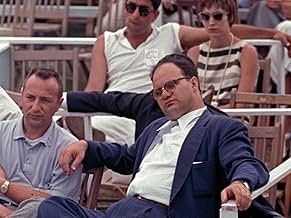CALIFICACIÓN DE IMDb
7.9/10
2.1 k
TU CALIFICACIÓN
Agrega una trama en tu idiomaThe highlights of the 1958 Newport Jazz Festival.The highlights of the 1958 Newport Jazz Festival.The highlights of the 1958 Newport Jazz Festival.
- Dirección
- Guionistas
- Elenco
- Premios
- 2 premios ganados en total
- Dirección
- Guionistas
- Todo el elenco y el equipo
- Producción, taquilla y más en IMDbPro
Opiniones destacadas
Not quite a concert film, not quite a travelogue, this "day and night in the life" of the Newport Jazz Festival is a delight. Some standout performances, including an unforgettable rendition of Sweet Georgia Brown by Anita O'Day and a gorgeous set by a beatific Mahalia Jackson would make this film worth watching all on their own. But, there's more. A very young Chuck Berry makes an appearance, and the earliest Rock and Roll seems boring by comparison to the many styles of jazz displayed in this film. Despite the repetitive groove, the folks in the audience can't help moving their feet to it and the future is foretold. Bert Stern deliberately moves the focus away from Berry's stage pyrotechnics and keeps it on the audience and the amused if bored jazz musicians. Did he know this was what the future held? Maybe. Bits and pieces of the lives of affluent Newport residents, a yacht race (America's Cup qualifying), jazz musicians practicing, a break into Bach by a cellist, dancing on the rooftops, all the small parts that make this film greater than their sum, this is one worth watching, and perhaps, like me, you'll find it one worth adding to your permanent library of musical film.
An exhilarating bullseye of music and spirit and a masterwork in aesthetics and observation.
Absolutely not a minute is wasted. Every decision of whether to show the performers, the audience, or the moments where it cuts to different scenes around the neighborhood (which could each function as a perfect short film on their own) all feels cohesively motivated in serving as a perfect testament to universal human joy and enthusiasm for creative spirits. The eye for capturing people in unguarded, emblematic moments serves as a fantastic precursor to Monterey Pop and Woodstock (as well as Neil Young's Weld but people aren't ready for that conversation yet) and its spirit was later taken to great effect by Jonathan Demme.
I get the sense that a great deal could be written about the larger cultural contexts that contributed to an object this pure and awesome being preserved, but for me its most inspiring as a testament to sensitive and committed people being on their absolute A-game for every aspect of production. This includes the people behind the camera having an acute sense for the perfect moments and angles to capture (and the showcase of lighting perfection from shot to shot, especially in such a free-form documentary setting, is absolute insanity), to the people responsible for the preservation of the film itself being so rich and beautiful, to the editors having an exacting sense of rhythm and kineticism (and making consistently creative and surprising choices among what must have been an intimidating amount of fantastic footage to curate), to the performers who each and every one of them manage at least one spellbinding and memorable moment (Anita O'Day being a total BEAST of a performer, Chuck Berry using a clarinet player to stunning effect, and Satchmo ascending to god form and winning music are just some of my favorites and I'm sure you'll have your own because every performance serves as a unique, full expression).
I cannot overstate what a revelation this film is, from the performances themselves to the cutaways to the life surrounding the festival, these are transcendent moments that form this fusion of music and image that feel like all of human existence was made in order to converge to this place and time, which is now available immaculately forever.
Absolutely not a minute is wasted. Every decision of whether to show the performers, the audience, or the moments where it cuts to different scenes around the neighborhood (which could each function as a perfect short film on their own) all feels cohesively motivated in serving as a perfect testament to universal human joy and enthusiasm for creative spirits. The eye for capturing people in unguarded, emblematic moments serves as a fantastic precursor to Monterey Pop and Woodstock (as well as Neil Young's Weld but people aren't ready for that conversation yet) and its spirit was later taken to great effect by Jonathan Demme.
I get the sense that a great deal could be written about the larger cultural contexts that contributed to an object this pure and awesome being preserved, but for me its most inspiring as a testament to sensitive and committed people being on their absolute A-game for every aspect of production. This includes the people behind the camera having an acute sense for the perfect moments and angles to capture (and the showcase of lighting perfection from shot to shot, especially in such a free-form documentary setting, is absolute insanity), to the people responsible for the preservation of the film itself being so rich and beautiful, to the editors having an exacting sense of rhythm and kineticism (and making consistently creative and surprising choices among what must have been an intimidating amount of fantastic footage to curate), to the performers who each and every one of them manage at least one spellbinding and memorable moment (Anita O'Day being a total BEAST of a performer, Chuck Berry using a clarinet player to stunning effect, and Satchmo ascending to god form and winning music are just some of my favorites and I'm sure you'll have your own because every performance serves as a unique, full expression).
I cannot overstate what a revelation this film is, from the performances themselves to the cutaways to the life surrounding the festival, these are transcendent moments that form this fusion of music and image that feel like all of human existence was made in order to converge to this place and time, which is now available immaculately forever.
This film really stuck with me, and so I feel compelled to say a few things about it.
It's one of the earliest concert films I've ever seen, and honestly maybe one of the better ones. I say that as someone who likes some jazz sometimes but wouldn't count it among my personal favourite music genres. That being said, the performances here are largely great, and it does a fantastic job of showing why jazz means so much to so many people. It conveys how fun jazz can be, how entertaining its musicians can be, the technical prowess involved, and also how it can be surprisingly moving.
Only a handful of names were familiar to me, but all proved entertaining to watch. Chuck Berry stood out in a slightly jarring way, being more of a rock artist than a jazz artist, but he ended up fitting in well. There's a nice flow to all the performers, I liked how it included the MC introducing them, and I loved the concert's progression from day to night.
In general, the visuals are what elevate this from being a good concert film with entertaining music and performances to a great concert film/ documentary. My favourite part might of been the montage of life in Newport on that day, about halfway through the film- of course it could have been filmed on a different day, but it's such great, hypnotic filmmaking that you don't think about it at the time. Seeing these people dancing, drinking, smoking, especially the people on the roof... it was surprisingly beautiful and moving.
I was born almost 40 years after this concert even took place, but somehow, it still managed to evoke a strong sense of nostalgia. I don't doubt that life was still complicated back then, and there were hardships and tribulations in the same way to how those things exist nowadays. Yet for 80-something minutes, you don't think about that. You're transported into a town that for one summer's day, in 1958, allowed all its citizens to have the time of their lives, and there's something incredibly and unexpectedly beautiful about that, even for a 25-year-old, very casual jazz fan like myself.
I'd recommend this to all fans of concert films and documentaries, or maybe just films in general. I'm happy to see a high score on here, but the low number of ratings is a little saddening. This deserves to be considered at least a minor classic, but even if that never happens, I'm glad I watched it, and am thankful to my grandfather for recommending it; without him, I may have never even heard of it.
It's one of the earliest concert films I've ever seen, and honestly maybe one of the better ones. I say that as someone who likes some jazz sometimes but wouldn't count it among my personal favourite music genres. That being said, the performances here are largely great, and it does a fantastic job of showing why jazz means so much to so many people. It conveys how fun jazz can be, how entertaining its musicians can be, the technical prowess involved, and also how it can be surprisingly moving.
Only a handful of names were familiar to me, but all proved entertaining to watch. Chuck Berry stood out in a slightly jarring way, being more of a rock artist than a jazz artist, but he ended up fitting in well. There's a nice flow to all the performers, I liked how it included the MC introducing them, and I loved the concert's progression from day to night.
In general, the visuals are what elevate this from being a good concert film with entertaining music and performances to a great concert film/ documentary. My favourite part might of been the montage of life in Newport on that day, about halfway through the film- of course it could have been filmed on a different day, but it's such great, hypnotic filmmaking that you don't think about it at the time. Seeing these people dancing, drinking, smoking, especially the people on the roof... it was surprisingly beautiful and moving.
I was born almost 40 years after this concert even took place, but somehow, it still managed to evoke a strong sense of nostalgia. I don't doubt that life was still complicated back then, and there were hardships and tribulations in the same way to how those things exist nowadays. Yet for 80-something minutes, you don't think about that. You're transported into a town that for one summer's day, in 1958, allowed all its citizens to have the time of their lives, and there's something incredibly and unexpectedly beautiful about that, even for a 25-year-old, very casual jazz fan like myself.
I'd recommend this to all fans of concert films and documentaries, or maybe just films in general. I'm happy to see a high score on here, but the low number of ratings is a little saddening. This deserves to be considered at least a minor classic, but even if that never happens, I'm glad I watched it, and am thankful to my grandfather for recommending it; without him, I may have never even heard of it.
Partly a jazz concert and partly a time capsule to a long ago era, "Jazz On A Summer's Day" records highlights of the four-day, 1958 festival held in Newport, Rhode Island. The film gets off to a slow start, with interviews of arriving audience, shots of Newport, and cutaways to the America's Cup yacht race, taking place concurrently.
About nine minutes into the film, the real program begins. The brilliant Thelonious Monk plays "Blue Monk" on the keys. From here on, most of the audio and visuals focus on the festival itself, except for brief visual cuts to the sailing event and impromptu shots of people enjoying themselves in presumably nearby locales. Although the film title says "day", about two-thirds of the film is shot at night.
Different styles of jazz provide ample variety, and run the gamut from an apparently unrelated boarding house jam session to the rockin', soul-stirring gospel music of Mahalia Jackson, who forcefully belts out three numbers at the end. Louis Armstrong and rarely filmed trombone legend Jack Teagarden perform a casual, seemingly improv vocal of "Old Rocking Chair". Dinah Washington singing "All Of Me", and the unusual percussion sounds of the Chico Hamilton Quintet are also quite good. But my personal favorite was Chuck Berry and band with a slowed down, beat thumpin' rendition of "Sweet Little Sixteen".
My only serious complaint is the film's editing, which includes the sailing event and quite a few extraneous visuals, and a too-brief overall runtime. A three-hour total jazz event would have been ideal.
The overall mood of the concert is upbeat, almost carnivalesque. The camera jumps back and forth between on-stage performers and audience reaction. Everyone seems to be having a good time. Glad to see this film recognized by the National Film Registry, to preserve an account of a unique event, held at a crucial moment in American history.
About nine minutes into the film, the real program begins. The brilliant Thelonious Monk plays "Blue Monk" on the keys. From here on, most of the audio and visuals focus on the festival itself, except for brief visual cuts to the sailing event and impromptu shots of people enjoying themselves in presumably nearby locales. Although the film title says "day", about two-thirds of the film is shot at night.
Different styles of jazz provide ample variety, and run the gamut from an apparently unrelated boarding house jam session to the rockin', soul-stirring gospel music of Mahalia Jackson, who forcefully belts out three numbers at the end. Louis Armstrong and rarely filmed trombone legend Jack Teagarden perform a casual, seemingly improv vocal of "Old Rocking Chair". Dinah Washington singing "All Of Me", and the unusual percussion sounds of the Chico Hamilton Quintet are also quite good. But my personal favorite was Chuck Berry and band with a slowed down, beat thumpin' rendition of "Sweet Little Sixteen".
My only serious complaint is the film's editing, which includes the sailing event and quite a few extraneous visuals, and a too-brief overall runtime. A three-hour total jazz event would have been ideal.
The overall mood of the concert is upbeat, almost carnivalesque. The camera jumps back and forth between on-stage performers and audience reaction. Everyone seems to be having a good time. Glad to see this film recognized by the National Film Registry, to preserve an account of a unique event, held at a crucial moment in American history.
10tavm
Anita O'Day singing "Sweet Georgia Brown". Dinah Washington warbling "All of Me" while also playing the xylophone. Chuck Berry playing guitar rocking to "Sweet Little Sixteen" while also doing his famous duck walk. Thelonious Monk on the piano. Gerry Mulligan with his band. Louis Armstrong and Jack Teagarden dueting on "Rocking Chair". And Mahalia Jackson ending the program on "The Lord's Prayer". All those I've cited are highlights of what I've seen in this great documentary of the Newport Jazz Festival of 1958 which ran at the same time as the America's Cup boat race of which some of that is also shown. And seeing all those shots of audience members having the time of their lives were also fine visually especially when one was seen singing along with one of Sachmo's songs. The whole thing was an overwhelming treat to watch so all I'll now say is Jazz on a Summer's Day is highly recommended.
¿Sabías que…?
- TriviaIn Hilton Als' 2008 New Yorker review of the documentary Anita O'Day: The Life of a Jazz Singer (2007), Als reports that Anita O'Day was high on heroin during her performance at the 1958 Newport Jazz Festival, and she was unaware that her performance was filmed until later. O'Day spoke frankly about her struggles with heroin addiction in her 1981 autobiography.
- Citas
Louis Armstrong: I was at a little Italian trumpet player's house, and his mother was a Countess, well they was makin' that spaghetti and we was wailin', you know. In this big ol' dinin' room they had this table and up in the ceilin' they had Mark Anthony and Cleo and all the cats that they painted. Lookin' down on you as if to say, "Man, you shore can eat!"
[laughs]
Louis Armstrong: Well, we have a lot of fun travelin', man.
Selecciones populares
Inicia sesión para calificar y agrega a la lista de videos para obtener recomendaciones personalizadas
- How long is Jazz on a Summer's Day?Con tecnología de Alexa
Detalles
- Fecha de lanzamiento
- País de origen
- Idioma
- También se conoce como
- Bert Stern's Jazz on a Summer's Day
- Locaciones de filmación
- Productoras
- Ver más créditos de la compañía en IMDbPro
Taquilla
- Total a nivel mundial
- USD 74,811
Contribuir a esta página
Sugiere una edición o agrega el contenido que falta





